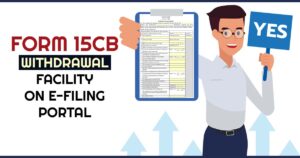![]()
User Intent
Users searching for Form 15CB are likely looking for an in-depth understanding of its purpose, application, and benefits. They might be tax
payers, accountants, or business owners dealing with foreign remittances who need to know when and how to use this form. This article provides a
step-by-step explanation to help them navigate tax compliance seamlessly.
Introduction
When making foreign remittances from India, taxpayers must comply with tax regulations to ensure proper documentation. One such essential document is Form 15CB, issued by a Chartered Accountant (CA). It confirms that the payer correctly applies tax deduction at source (TDS) before transferring funds abroad.
Understanding when and why taxpayers require this form helps avoid penalties and ensures smooth transactions.
Definition of Form 15CB
A Chartered Accountant issues Form 15CB as per Rule 37BB of the Income Tax Rules, 1962. It verifies that they have correctly determined the applicable tax liability on an international remittance before processing the payment.
This certification ensures that the payment complies with Indian tax laws and the Double Taxation Avoidance Agreement (DTAA) (if applicable). It provides details about nature, amount, and applicable tax rates on the remittance.
Application of Form 15CB
Specific cases of foreign remittance require Form 15CB when the payment exceeds a certain threshold or when tax deduction applies. Below is a detailed step-by-step explanation of its application:
1: Identifying the Nature of Remittance
- The remitter must determine the purpose of the transaction.
- Some transactions fall under exempt categories, where Form 15CB is not mandatory (such as certain trade payments and personal remittances).
2: Checking for TDS Applicability
- If tax is required to be deducted on the remittance, a CA must certify the applicable tax rate.
- The form also ensures that DTAA benefits, if available, are applied correctly.
3: Issuance of Form 15CB
- The remitter submits transaction details to a Chartered Accountant.
- The CA verifies taxability, rates, and DTAA applicability.
- After verification, the CA issues Form 15CB through the Income Tax e-Filing portal.
4: Submission Along with Form 15CA
- After generating Form 15CB, the remitter fills out Form 15CA and submits it online.
- The bank requires both forms before processing the foreign remittance.
Benefits of Form 15CB
- Ensures Compliance: It helps businesses and individuals avoid legal penalties by ensuring compliance with Indian tax laws.
- Prevents Tax Evasion: By verifying tax liability, it ensures that correct taxes are deducted and paid to the government.
- Supports International Transactions: Businesses making frequent international payments benefit from hassle-free remittance processing.
- Certifies Accuracy: Since a CA certifies the form, it provides credibility and accuracy in tax compliance.
- Enables DTAA Benefits: Taxpayers can avail of lower tax rates under DTAA provisions, reducing the tax burden.
Limitations of Form 15CB
Despite its benefits, Form 15CB has a few limitations:
- Not Required for All Transactions: It is unnecessary for certain exempt remittances, which may cause confusion.
- Dependence on Chartered Accountants: Since only CAs can issue this form, taxpayers rely on their availability.
- Time-Consuming Process: Gathering remittance details, tax calculations, and CA certification may delay payments.
- Complex for Small Businesses: Small enterprises may find the compliance process burdensome due to additional paperwork.
- Online Portal Challenges: Technical glitches or delays in e-filing portals can disrupt the remittance process.
Comparative Table: Form 15CB vs. Form 15CA
| Feature | Form 15CB | Form 15CA |
|---|---|---|
| Issued by | Chartered Accountant | Taxpayer |
| Purpose | Certifies tax deduction compliance | Declares details of foreign remittance |
| When Required | When tax is deductible and remittance exceeds limit | Required for all remittances |
| Submission | Issued on CA’s recommendation | Filed online via Income Tax Portal |
| Documentation | Includes tax calculations & DTAA provisions | Includes transaction details |
| Mandatory For | High-value taxable remittances | All remittances unless exempt |
Conclusion
Form 15CB is a critical document for tax compliance in foreign remittances. It ensures proper tax deduction and prevents tax evasion, making it an essential tool for businesses and individuals dealing with international transactions. However, it applies only to cases where tax deduction is necessary.. By understanding the process, benefits, and limitations, taxpayers can ensure smooth remittance transactions without legal complications.
FAQs
1. When is Form 15CB required?
It is required when a foreign remittance is taxable and exceeds a specified limit.
2. Can I file Form 15CB myself?
No, only a Chartered Accountant can issue Form 15CB.
3. What happens if I fail to submit Form 15CB?
Failure to submit it may result in delays or penalties in processing foreign remittances.
4. Is Form 15CB required for all foreign transactions?
Exempted transactions, like certain trade payments and personal remittances, do not require it.
5. How do I submit Form 15CB online?
A CA issues it through the Income Tax e-Filing portal, and the taxpayer must submit it along with Form 15CA to the bank.

To visit: https://www.incometax.gov.in
